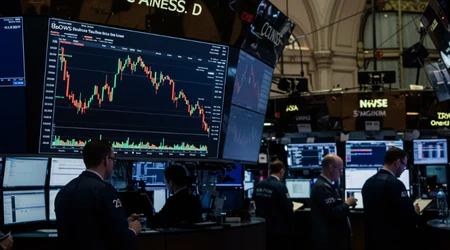Pound Drops to Ten‑Week Low After US–EU Trade Deal Sparks Currency Volatility

Pound drops to ten-week low as the US-EU trade deal, finalized on July 27, 2025, sends shockwaves through global currency markets, unsettling Sterling.
This agreement, reducing tariffs to a baseline of 15%, has bolstered the US dollar, leaving the British pound reeling at $1.3400 against the greenback.
Investors, rattled by the deal’s implications, are recalibrating expectations, with the Bank of England’s looming August 7 rate decision adding fuel to the fire.
What does this mean for the UK’s economic trajectory? This article unpacks the forces driving Sterling’s slide, offering a clear-eyed view of the road ahead.
The deal, hailed as a breakthrough by US President Donald Trump and European Commission President Ursula von der Leyen, has shifted market dynamics overnight.
It’s not just about tariffs; it’s about confidence, risk appetite, and the delicate balance of global trade. Sterling’s fall reflects broader uncertainties UK stagflation risks, weakening retail sales, and a potential Bank of England rate cut.
Meanwhile, the dollar’s surge underscores America’s economic resilience. This introduction sets the stage for a deep dive into the causes, consequences, and future of the pound’s turbulent journey.
Why the Pound Is Under Pressure
The pound drops to ten-week low as markets digest the US-EU trade deal’s ripple effects, which have strengthened the dollar and weakened risk-sensitive currencies.
The agreement, reducing tariffs to 15% from a threatened 50%, has calmed fears of a trade war but boosted US economic optimism.
Sterling, already fragile, slipped to $1.3407 on July 28, 2025, per ExchangeRates.org.uk. UK retail sales fell 0.6% in June, signaling consumer caution, further denting confidence in the pound.
Beyond the trade deal, domestic pressures weigh heavily on Sterling. Rising stagflation fears, driven by stagnant growth and spiking costs, haunt the UK economy.
National Insurance hikes have fueled wage demands, pushing inflation higher. S&P Global’s Chris Williamson noted, “Stagnant growth paired with rising input costs is a dangerous mix.”
++ UK-France Sign ‘Northwood Declaration’: First Ever Nuclear Cooperation Pact
This toxic combination leaves the pound vulnerable, as investors brace for a possible 25-basis-point rate cut from the Bank of England.
Adding to the strain, the UK’s economic calendar is sparse, leaving Sterling exposed to global risk sentiment.
The US, by contrast, benefits from robust data releases, like consumer confidence expected to rise in July.
This divergence in economic fortunes amplifies the dollar’s appeal, leaving the pound to weather the storm. Investors are now eyeing US-China trade talks in Stockholm, which could further sway currency markets.

The US-EU Trade Deal: A Double-Edged Sword
The US-EU trade deal, while averting a tariff cliff, has sparked unintended consequences for Sterling, as the pound drops to ten-week low.
By setting tariffs at 15%, the deal has spurred demand for riskier assets, yet the dollar’s safe-haven status prevails.
The agreement, finalized over the weekend, has reduced uncertainty around the August 1 deadline, but markets remain jittery about its long-term economic fallout.
For the UK, the deal’s benefits are murky. As a non-EU member, Britain faces indirect effects through global trade shifts.
Also read: High Court Rules on Major Immigration Policy Challenge
European markets, buoyed by the deal, saw the euro climb to $1.1770, while Sterling lagged. This dynamic highlights the pound’s sensitivity to external shocks. Imagine a tightrope walker Sterling teeters as global winds shift, with no safety net in sight.
Moreover, the deal has recalibrated investor expectations. UBS warns of lingering volatility, noting US tariffs are still six times higher than pre-Liberation Day levels.
This uncertainty keeps markets on edge, with the pound caught in the crossfire. As US-China talks loom, further turbulence could exacerbate Sterling’s woes, especially if tariff truces extend.
The UK’s post-Brexit trade isolation adds another layer of complexity. Without direct access to the US-EU framework, British exporters face competitive disadvantages.
The pound’s decline mirrors this reality, as global investors pivot toward stronger currencies.
For businesses, this means higher import costs, squeezing margins. The deal, while a global win, leaves Sterling grappling with its diminished influence.
Bank of England’s Looming Decision
With the pound drops to ten-week low, all eyes turn to the Bank of England’s August 7 meeting, where a rate cut seems likely.
Cooling labor markets, with UK employment dropping at its fastest pace since January, signal economic fragility. Markets have priced in a 25-basis-point cut, which could further erode Sterling’s value against a resurgent dollar.
A rate cut, while aimed at spurring growth, risks fueling inflation already stoked by rising costs. National Insurance hikes have driven wage pressures, creating a feedback loop of price increases.
This stagflationary trap leaves policymakers in a bind support growth or tame inflation? The pound’s recent slide suggests markets are betting on the former, with bearish sentiment dominating.
Read more: Third Consecutive Heatwave Hits UK Amid Water Crisis and Drought
Compounding the issue, the UK lacks robust data releases to bolster confidence. Unlike the US, where job openings and consumer confidence data drive optimism, Britain’s economic indicators are lackluster.
The pound’s near-term trend remains bearish, with technical indicators like the Head and Shoulders pattern signaling further downside. A rate cut could push Sterling toward its May 12 low of $1.3140.
The Bank’s decision will also ripple through UK households. For example, a London-based importer, Sarah, faces higher costs as the pound weakens, forcing price hikes on consumers.
Conversely, exporters like James, a Manchester manufacturer, gain competitiveness but struggle with volatile input costs. These real-world impacts underscore the stakes of the Bank’s next move, as Sterling navigates uncharted waters.
Global Currency Volatility: A Broader Context
The pound drops to ten-week low amid a broader surge in currency volatility, driven by the US-EU deal and shifting global risk dynamics.
The dollar’s strength, with the US Dollar Index hitting 97.90, reflects America’s economic outperformance. Meanwhile, safe-haven currencies like the yen and Swiss franc have softened, as optimism over trade deals reduces demand for havens.
This volatility isn’t unique to Sterling. The euro, despite initial gains, fell 1% to $1.1618 on July 28, its worst drop since May.
Currency markets are a seesaw, with the dollar’s rise tilting the balance. For the UK, this means Sterling is squeezed between a hawkish Federal Reserve and a dovish Bank of England, amplifying price swings.
Geopolitical factors add fuel to the fire. Upcoming US-China trade talks in Stockholm could extend the tariff truce, potentially stabilizing markets.
However, any misstep risks reigniting volatility. The pound, already battered, faces further pressure if global risk appetite shifts. Investors are hedging heavily, with options volumes surging to a two-year high.
Consider a small UK retailer importing electronics from the US. A weaker pound means higher costs, forcing price increases or margin cuts.
This microcosm reflects broader market dynamics, where currency swings dictate economic outcomes. As volatility persists, the pound’s path hinges on global trade developments and domestic policy responses.
Table: Key Currency Movements Post US-EU Trade Deal (July 28, 2025)
| Currency Pair | Value (July 28) | Change (%) | Notes |
|---|---|---|---|
| GBP/USD | $1.3407 | -0.5% | Hit 10-week low after deal |
| EUR/USD | $1.1770 | +0.2% | Gained on trade optimism |
| USD/JPY | 143.50 | -0.3% | Yen weakened as safe-haven demand fell |
| USD Index | 97.90 | +0.4% | Dollar rose on US economic strength |
Source: ExchangeRates.org.uk, Mitrade
What Lies Ahead for Sterling?
As the pound drops to ten-week low, its future hinges on a delicate interplay of domestic policy and global trade dynamics.
Forecasts suggest GBP/USD could climb to 1.37 by year-end, per Wells Fargo, but only if UK growth surprises. Persistent stagflation risks and a potential rate cut cloud this outlook, keeping Sterling under pressure.
Long-term, the pound’s resilience depends on UK economic recovery. Fiscal stimulus could spark growth in 2026, but near-term challenges loom large.
Cambridge Currencies predicts GBP/EUR may hit 1.20 by December if global markets stabilize. Yet, with US data releases dominating, the dollar’s strength could cap Sterling’s gains.
Hedging strategies are critical for businesses. Forward contracts, as Cambridge Currencies suggests, can lock in rates, shielding firms from volatility.
For individuals, timing currency exchanges is key. With the pound above pandemic-era lows, now may be a strategic moment to act, though caution is warranted.
The interplay of these factors creates a complex landscape. Will the Bank of England’s next move stabilize or further unsettle Sterling?
Investors and businesses must stay nimble, as global trade talks and domestic data shape the pound’s trajectory. The road ahead is fraught, but opportunities may emerge for the astute.
Frequently Asked Questions
Why did the pound drop to a ten-week low?
The pound drops to ten-week low due to the US-EU trade deal boosting the dollar, UK stagflation fears, and expectations of a Bank of England rate cut.
How does the US-EU trade deal affect the UK?
The deal strengthens the dollar and euro, indirectly pressuring Sterling by shifting global trade dynamics and highlighting the UK’s post-Brexit vulnerabilities.
What can businesses do to manage currency volatility?
Businesses can use forward contracts to lock in exchange rates, as suggested by Cambridge Currencies, mitigating losses from sudden pound fluctuations.
Will the pound recover soon?
Recovery depends on UK growth and Bank of England policy. Wells Fargo forecasts GBP/USD at 1.37 by year-end, but risks remain.
